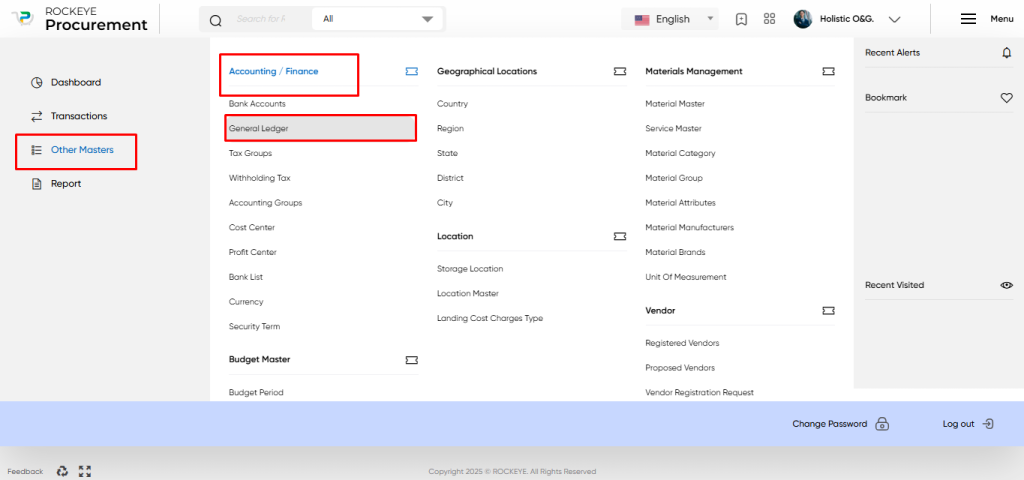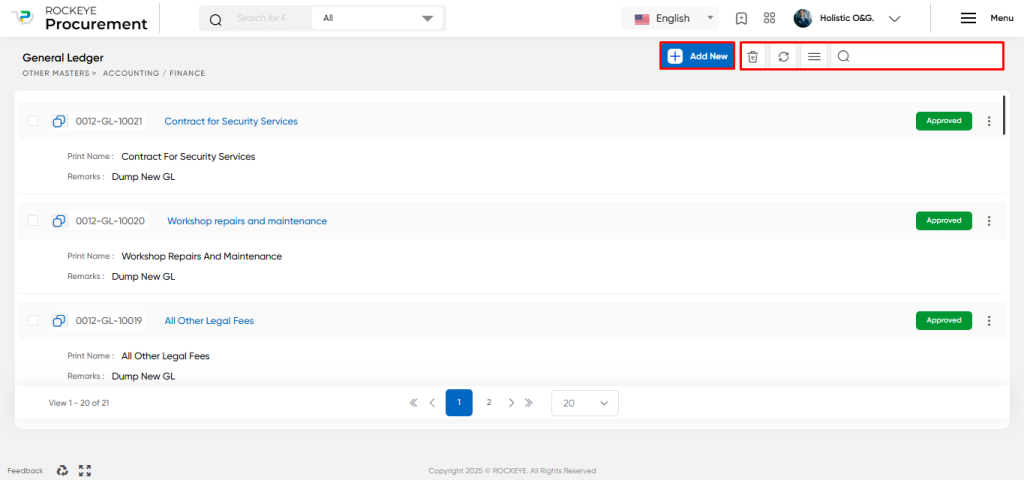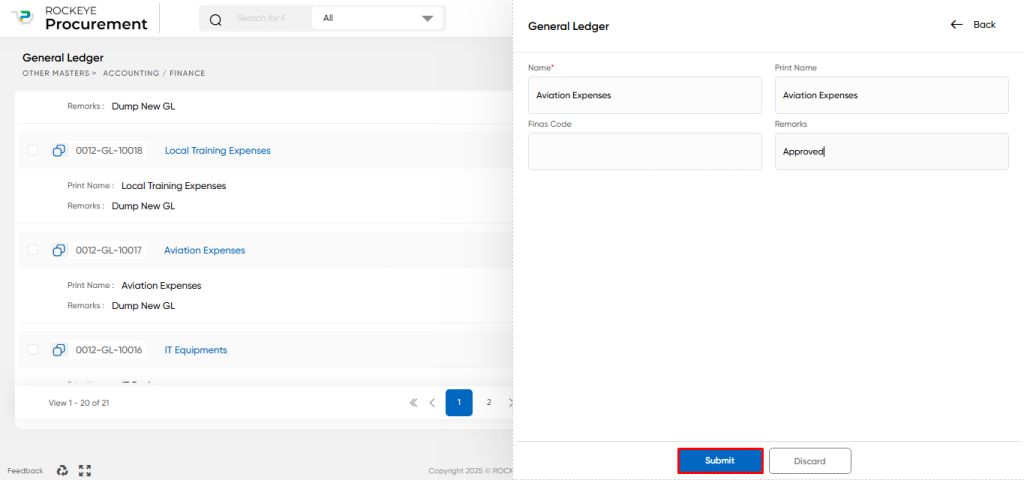General Ledger
Introduction/Purpose:
In a procurement system, the general ledger master plays a crucial role in recording, organizing, and managing financial information related to procurement activities. It serves as a central repository for all financial transactions and provides a comprehensive view of the organization’s financial data.
To ensure accurate and reliable accounting records, the procurement system is integrated with the FINAS (Financial Accounting System) system. This integration allows procurement users to add or fetch general ledger codes from the list of general ledgers available in the FINAS system. By selecting a specific general ledger, the corresponding FINAS GL code is automatically fetched and associated with the procurement transaction.
Furthermore, the general ledger is linked with other master data and modules within the procurement system, such as accounting groups. This linkage establishes relationships between different components of the financial system, facilitating proper categorisation and classification of financial transactions.
By maintaining a comprehensive general ledger master, organisations can generate a variety of financial reports, including balance sheets, income statements, and cash flow statements. These reports provide insights into the financial health of the procurement process, allowing stakeholders to assess profitability, monitor expenses, and make informed decisions regarding procurement activities.
Overall, the general ledger master in a procurement system, integrated with the FINAS system, ensures accurate financial recording and synchronisation between systems and provides a foundation for generating financial reports. It plays a vital role in maintaining transparent and reliable financial records, supporting effective financial management and decision-making in procurement processes.
Dependency:
The General Ledger (GL) master in a procurement system has several dependencies that are crucial for its proper functioning and effectiveness. These dependencies include:
- Integration with Financial Systems: The GL master is typically integrated with the organization’s broader financial systems, such as the financial accounting system or enterprise resource planning (ERP) system. This integration ensures the synchronization of financial data between the procurement system and other modules or applications. The GL master depends on this integration to maintain the consistency and accuracy of financial records across different systems.
Overall, the GL master in a procurement system is dependent on the chart of accounts, integration with financial systems, accurate master data management, recording of procurement transactions, implementation of internal controls and policies, and user input and validation. These dependencies work together to ensure the accuracy, reliability, and effectiveness of the GL master in supporting procurement-related financial processes.
How To Navigate:
The navigation to record a general ledger in a procurement system typically involves the following steps:
- Click on the main navigation icon: The main navigation icon may be located in the top right corner of the screen. Clicking on this icon will open the navigation menu, which typically includes links to various sections of the procurement system.
- Click on the Other Masters section: The Other Masters section is located under the left section of the screen; clicking on this section will display a list of masters related to procuring.
- Find the Accounts/Finance section: The Accounts/Finance section is located in the list of Master under the Master section. Clicking on this section will display a list of masters related to accounts/finance.
- Click on the General Ledger link: The General Ledger link is located under the Accounts/Finance section. After clicking on this link, you can navigate to General Ledger in the listing, and from that you can easily upload new transactions into the system.

Listing:
In a procurement system, the General Ledger (GL) master listing provides a user-friendly interface to manage and access GL accounts. It typically includes various features and options to facilitate efficient navigation and manipulation of GL data. Here’s a breakdown of the commonly available features in a GL master listing in a procurement system:

- Delete: This option allows users to delete GL accounts that are no longer needed or have become obsolete. It helps keep the GL master organised and removes unnecessary accounts.
- Refresh: The refresh option allows users to update the GL master listing and retrieve the latest data. It ensures that any changes made by other users or system updates are reflected in real-time.
- Search: The search functionality enables users to find specific GL accounts based on predefined search criteria. Users can search by GL name, Finas code, or other relevant parameters to quickly locate the desired GL account.
- Export: The Export option allows users to export the GL master listing data to external file formats such as Excel, CSV, or PDF. This feature enables users to save or share the GL account information for further analysis, reporting, or archival purposes.
- Conditional Search: This feature extends the search functionality by allowing users to perform more complex searches based on conditional criteria. Users can specify additional conditions, such as filtering GL accounts based on specific financial metrics or date ranges.
- Card View: The card view provides a visual representation of GL accounts in a concise and structured manner. Each GL account is displayed as a card or tile, showing key information such as GL name, Finas code, print name, and remarks. This view allows users to quickly scan and identify relevant GL accounts.
- Activity Log: The activity log captures and displays a history of changes made to GL accounts. It provides an audit trail, documenting actions such as GL creation, modifications, or deletions. The activity log helps track and review changes, enhancing accountability and transparency.
These features and options enhance the usability and functionality of the GL master listing in a procurement system. They enable users to efficiently manage, search, and export GL accounts, ensuring easy access to accurate financial data for procurement-related activities.
Recording & Update:
In the procurement system, when adding a General Ledger (GL), the user is presented with a suggestion list of GL accounts. If the user selects a GL from the suggested list, the corresponding Finas Code and GL Name will be auto-filled. This ensures that the GL is properly linked with the FINAS system. However, if the user manually enters a GL that is not from the suggested list, the Finas Code will not be automatically filled, even if the same code exists in the FINAS system.

To add a GL in the procurement system, the user needs to fill in the following fields:
- General Ledger Name: This field captures the name or description of the GL account. It helps identify and categorize the GL for financial recording and reporting purposes.
- FINAS CODE: This field is used to enter the specific code associated with the GL account in the FINAS system. If the user selects a GL from the suggestion list, this field will be auto-filled. Otherwise, the user needs to manually enter the appropriate FINAS code.
- Print NAME of GL: This field allows the user to enter a print name for the GL. The print name is typically a shorter or more concise version of the GL name and is used for printing or displaying purposes.
- Remark: The remark field provides an optional space for the user to add additional notes or comments regarding the GL account. It can be used to provide further context or details about the GL.
Once a GL has been created, it is important to note that updates or modifications to the GL account are not allowed. This ensures data integrity and prevents unintended changes to GL information. If any updates or changes are required for a GL, it may involve creating a new GL account or following a designated process for GL modifications, depending on the system’s configuration and business rules.
By adhering to this process, the procurement system ensures the accurate creation and recording of GL accounts while maintaining data consistency with the linked FINAS system.
The user can perform the following actions in this section:
- Submit: This option allows the user to publish the transaction information. If the system has an approval flow, the maker will submit the information, and it will be sent to the approval authority or checker for approval.
- Discard: This option allows the user to discard the transaction before saving it.
Key Notes General Ledger:
- The GL needs an automatically filled FINAS Code to be linked with the FINAS system; otherwise, it won’t have any connection even if the GL name is the same.